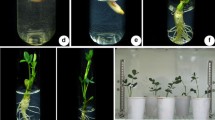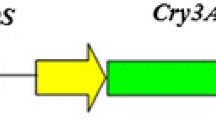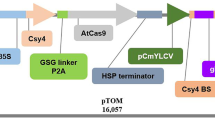Abstract
To introduce genetic resistance against alfalfa weevil (Hypera postica), leaves and petiole explants of three commercial alfalfa genotypes, including Km-27, Kk-14 and Syn-18 were transformed with Agrobacterium tumefaciens strains GV101, LBA4404 and AGL01. All the Agrobacterium strains used harbored the recombinant binary vector pBI121 containing a synthetic cry3a gene under the control of CaMV35S promoter as well as the nptII gene as selectable marker. Transformed explants were cultured on callus-induction medium, and the germinated somatic embryos were then transferred to the regeneration medium. The primary transformants were evaluated by PCR and Southern blot analysis. The results indicated successful integration of the target gene into the genomes of primary transgenic lines. Moreover, the expression of Cry3a protein in the transgenic plants was confirmed by ELISA method. Three transgenic lines, including TL6, TL8 and TL11 showed significantly higher levels of insect resistance against H. postica larvae (mortality rate of 73–90 % after infestation), in comparison with the control plants during the two-year bioassays. All transgenic plants were fertile and no irregular behavior in terms of growth and the morphological traits were observed. Transgenic plants developed during the course of this study are currently being grown in greenhouse and will be crossed with each other for seed production.




Similar content being viewed by others
Abbreviations
- Bio2Y:
-
Blaydes 1966 medium
- CaMV:
-
Cauliflower mosaic virus
- DIG:
-
Digoxigenin-dUTP
- 2,4-D:
-
2,4-dichlorophenoxyacetic acid
- ELISA:
-
Enzyme-linked immunosorbent assay
- MS:
-
Murashige and Shoog medium (1962)
- nptII:
-
Neomycin phosphotransferase gene
- Nos:
-
Nopaline synthase
- OD:
-
Optical density
References
Austin S, Bingham ET, Mathews DE, Shahan MN, Will J, Burgess RR, Cassells AC, Jones PW (1995) Production and field performance of transgenic alfalfa (Medicago sativa L.) expressing alpha-amylase and manganese-dependent lignin peroxidase. Euphytica 85:381–393
Bao A-K, Wang SM, Wu GQ, Xi JJ, Zhang JL, Wang CM (2009) Overexpression of the Arabidopsis H+-PPase enhanced resistance to salt and drought stress in transgenic alfalfa (Medicago sativa L.). Plant Sci 176:232–240
Bharathi Y, Vijayakumar S, China PI, Dasavantha R, Venkateswara R (2008) Transgenic rice expressing Allium sativum leaf agglutinin (ASAL) exhibits high-level resistance against major sap-sucking pests. BMC Plant Biol 8:102–117
Bhat SR, Srinivasan S (2002) Molecular and genetic analyses of transgenic plants considerations and approach. Plant Sci 163:673–681
Bingham E (1991) Registration of alfalfa hybrid Regen-SY germplasm for tissue culture and transformation. Crop Sci 31:1098–1118
Blaydes DF (1966) Interaction of kinetin and various inhibitors in the growth of soybean tissue. Physiol Plant 19:748–753
Chandra A, Pandey KC (2008) Effect of proteinase inhibitors on Indian alfalfa weevil (Hypera postica Gyll.) growth and development. Acta Physiol Plantarum 30:501–505
Desgagnés R, Serge L, Guy A, Habib YC, Jacques L, Réal M, Louis-P V (1995) Genetic transformation of commercial breeding lines of alfalfa (Medicago sativa). Plant Cell Tiss Org Cult 42:129–140
Ghareyazie B, Alinia F, Menguito CA, Rubia LG, Palma JM, Liwanag EA, Cohen MB, Bennett J, Khush GS (1997) Enhanced resistance to two stem borers in an aromatic rice containing a synthetic cryIA(b) gene. Mol Breed 3:401–414
González et al (2008) Efficient regeneration and Agrobacterium tumefaciens mediated transformation of recalcitrant sweet potato (Ipomoea batatas L.) cultivars. Asia Pac J Mol Biol Biotechnol 16:25–33
Hibbard BE, Clark TL, Ellersieck MR, Meihls LN, El Khishen AA, Kaster V, Steiner HY, Kurtz R (2010) Mortality of western corn rootworm larvae on MIR604 transgenic maize roots: field survivorship has no significant impact on survivorship of F1 progeny on MIR604. J Econ Entomol 103:2187–2196
Hoefte H, Whiteley HR (1989) Insecticidal Crystal proteins of Bacillus thuringiensisa. Microbiol Rev 53:242–255
James C (2011) Global status of commercialized biotech/GM crops: brief 43, International Service for the Acquisition of Agribiotech Applications ISAAA, pp 1-16
Jiang Q, Zhang JY, Guo X, Monteros MJ, Wang ZY (2009) Physiological characterization of transgenic Alfalfa (Medicago sativa) plants for improved drought tolerance. Int J Plant Sci 170:969–978
Jin T, Chang Q, Li W, Yin D, Li Z, Wang D, Liu B, Liu L (2010) Stress-inducible expression of GmDREB1 conferred salt tolerance in transgenic alfalfa. Plant Cell Tissue Organ Cult 100:219–227
Jouzani GS, Komakhin RA, Piruzian ES (2005) Comparative study of the expression of the native, modified, and hybrid cry3a genes of Bacillus thuringiensis in prokaryotic and eukaryotic cells. Russ J Genet 4:116–121
Jouzani GS, Goldenkova IV, Piruzian ES (2008) Expression of hybrid cry3aM-licBM2 genes in transgenic potatoes (Solanum tuberusom). Plant Cell Tissue Organ Cult 92:321–325
Kechang L, Ping Z, Cash D (2009) Biology and management of major alfalfa diseases and pests. In: Cash D, Yuegao H, Kechang L, Suqin W, Ping Z, Rong G (eds) Alfalfa management guide for ningxia. China Agricultural Press, China, pp 37–62
Khanjani M (ed) (2005) Alfalfa pests. In: Crop pests in Iran. Ali Sina University Press, Iran, pp 121-138
Krieg, Aloisius, Huger, Alois S (1989) Protein toxin from Bacillus thuringiensis which is toxic to coleopteran. Patent US 4889918
Kuiper HA, Kleter GA, Hub N, Kok EJ (2001) Assessment of the food safety issues related to genetically modified foods. Plant J 27:503–528
Li H, Jinhua L, Hemphill JK, Wang JT, Gould J (2001) A rapid and high yielding DNA miniprep for cotton (Gossypium spp.). Plant Mol Biol Rep 19:183a–183e
Ma XF, Tudor S, Butler T, Ge Y, Xi Y, Bouton J, Harrison MYuZW (2012) Transgenic expression of phytase and acid phosphatase genes in alfalfa (Medicago sativa) leads to improved phosphate uptake in natural soils. Mol Breed 30:377–391
Mesfin TM, Matthew DD, Deborah A, Samac C, Vance P (2005) Transgenic alfalfa secretes a fungal endochitinase protein to the rhizosphere. Plant Soil 269:233–243
Meyer P (1985) Understanding and controlling transgene expression. Trends Biotechnol 13:332–337
Pires AS, Rosa S, Castanheira S, Fevereiro P, Abranches R (2012) Expression of a recombinant human erythropoietin in suspension cell cultures of Arabidopsis, tobacco and Medicago. Plant Cell Tissue Organ Cult 110:171–181
Samac DA (1995) Strain specificity in the transformation of alfalfa (Medicago sativa) by Agrobacterium tumefaciens. Plant Cell Tissue Organ Cult 43:271–277
Samac DA, Smigocki AC (2003) Expression of oryzacystatin I and II in transgenic alfalfa increases resistance to the root-lesion nematode. Phytopathol 93:799–804
Schluter U, Benchabane M, Lie AM, Kiggundu A, Vorster J, Goulet MC, Cloutier C, Michaud D (2010) Recombinant protease inhibitors for herbivore pest control: a multitrophic perspective. J Exp Bot 61:4169–4183
Smith DS, Maxwell PW, De Boer SH (2004) Method for the detection of synthetic cry3A in transgenic potatoes. J Agric Food Chem 25:809–815
Srivastava V, Ow DW (2001) Single-copy primary transformants of maize obtained through the co-introduction of a recombinase-expressing construct. Plant Mol Biol 46:561–566
Tesfaye M, Samac DA, Lamb JFS (2009) Alfalfa. In: Chittaranjan K, Timotry CH (eds) Compendium of transgenic crop. Wiley, New York, pp 199–210
Tohidfar M, Ghareyazie B, Mousavi M, Yazdani S, Golabchian R (2008) Agrobacterium mediated transformation of cotton (Gossypium hirsutum) using a syntheticcry1Ab gene for enhanced resistance against Heliothis armigera. Iran J Biotechnol 6:164–173
Wilhite SE, Elden TC, Brzin J, Smigocki AC (2000) Inhibition of cysteine and aspartyl proteinases in the alfalfa weevil midgut with biochemical and plant-derived proteinase inhibitors. Insect Biochem Mol Biol 30:1181–1188
Yan LP et al (2012) Physiological responses to salt stress of T2 alfalfa progenies carrying a transgene for betaine aldehyde dehydrogenase. Plant Cell Tissue Org Cult 108:191–199
Zhang Y, Liu J (2011) Transgenic alfalfa plants co-expressing glutathione S-transferase (GST) and human CYP2E1 show enhanced resistance to mixed contaminates of heavy metals and organic pollutants. J Hazard Mat 189:357–362
Zhang B, Chen M, Zhang X, Luan H, Diao S, Tian Y, Su X (2011) Laboratory and field evaluation of the transgenic Populus alba × Populus glandulosa expressing double coleopteran-resistance genes. Tree Physiol 31:567–573
Zhang YM, Liu ZH, Wen ZY, Zhang HM, Yang F, Guo XL (2012) The vacuolar Na+–H+ antiport gene TaNHX2 confers salt tolerance on transgenic alfalfa (Medicago sativa). Funct Plant Biol, Published online 18 July 2012
Acknowledgments
This work was supported by a grant received from the Agricultural Research and Education Organization of Iran (AREO). We wish to thank all our colleagues in the Department of Plant Tissue Culture and Genetic engineering of ABRII for their support and technical assistance. The authors would also like to extend their appreciation to Assist. Prof. Meisam Tabatabaei for his critical review of the manuscript in terms of its academic English writing.
Author information
Authors and Affiliations
Corresponding author
Rights and permissions
About this article
Cite this article
Tohidfar, M., Zare, N., Jouzani, G.S. et al. Agrobacterium-mediated transformation of alfalfa (Medicago sativa) using a synthetic cry3a gene to enhance resistance against alfalfa weevil. Plant Cell Tiss Organ Cult 113, 227–235 (2013). https://doi.org/10.1007/s11240-012-0262-2
Received:
Accepted:
Published:
Issue Date:
DOI: https://doi.org/10.1007/s11240-012-0262-2




